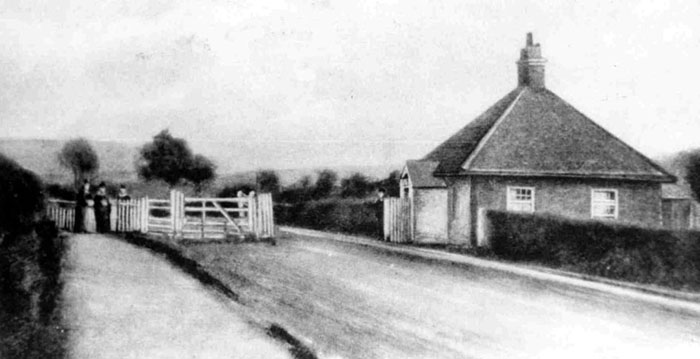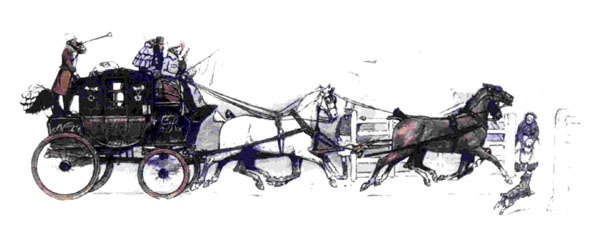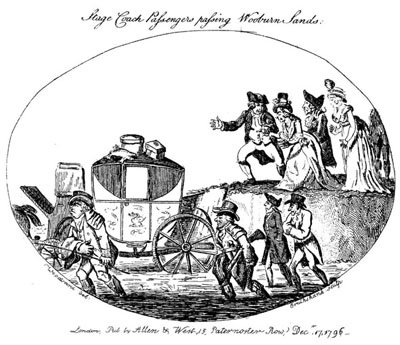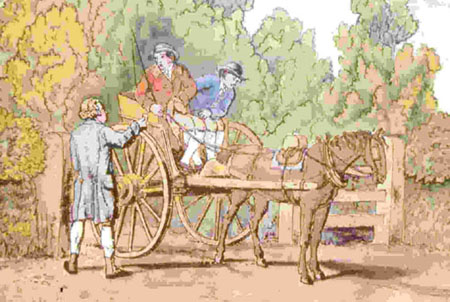|
Dunstable Turnpikes
|
||
|
Dunstable Toll Gate By Rita Swift The subject of the Toll Gate near Dunstable on the road to Kensworth (shown in the painting above) had been under
discussion at a Dunstable council meeting in 1871. It was proving detrimental
to the town with farmers and gardeners etc preferring to go to However in 1877 the matter was finally resolved, thanks to the persistent efforts of Alderman Lockhart and some other gentlemen. The decision was made to close the Toll Gate on the October 31 1877, with the gate and the house to be demolished soon after. William Shuttleworth, the keeper of the tollhouse, opened the gates just before midnight on October 31 to allow all travellers free access. Soon afterwards a number of people came from the direction of Dunstable led by a band and as the clock struck 12, although the gate was open, they began to attack and destroy it. Mr Shuttleworth tried to calm them down, even offering them wine, but they swore and threatened to physically abuse him. He retreated, frightened and shaking, to his house but not before he had recognised, and could name four of the ringleaders. Later in court he explained that others participating he only knew by sight but not by name. Stones were thrown at the lamps, which together with the palings were torn down and smashed. The notice board with the list of tolls and the gate were torn down and set on fire with the disturbance continuing until two o'clock in the morning. The following week at Hemel Hempstead Petty Sessions,Henry Burgess, Frederick Lathain, Frederick Pitkin and Henry Limbrey all of Dunstable, were charged by Mr. William Shuttleworth of Kensworth with damaging a gate, pales, lamp and other articles, the property of the trustees of the Dunstable and Pondyards Turnpike Trust, to the value of £2. Mr. Edward W. Beal prosecuted. A verdict of guilty was pronounced and the defendants were ordered to pay £2 damages and £4. 8s 6d costs. Puddle Hill Turnpike Trust By Rita Swift In April 1873 it was announced that the “Pike” between Dunstable and Hockliffe known as the Puddlehill Gate, was to be abolished along with some others but not the one on the south side of Dunstable. Its sale was placed in the hands of Mr W H Derbyshire, the auctioneer, who advertised it in the local paper. Interesting details are therefore preserved. The advertisement read: 29 October 1873 Near Hockliffe, Beds MR. W. H. DERBYSHIRE has been favoured with instructions from the
Trustees of the Puddle-Hill Turnpike Trust Conditions will be produced at the time of sale, and further
particulars may be obtained of C. S. BENNINGS, Esq., Clerk of the above Trustees, or of the AUCTIONEER, both of Dunstable. |
||
|
|
||
Success and failure of the Turnpike TrustsBy Omer Roucoux previously published in Dunstable and District Local History Society Newsletter n°25 – February 2006 – p.170 - 173 In the time of Queen Anne, at the beginning of the 18th century, we had
great ships sending goods to The section of the Fortunately "there is a very good pitched causeway for foote-people and horse that is raised up high from the road, and a very steepe chalky hill from whence it has its name Chalk Hill just as you enter Dunstable .. it is a good town ... full of inns ...". There are various reasons why the roads had reached such a pitiful state. During many centuries the care of the local roads was in charge of each parish. There was no effective highway authority, either local or central. An Act passed in 1555 - 'Act for Mending of Highwayes' - officially put the parishes in charge of the upkeep of the King's highways. But this Act was a dismal failure. The surveyors were unpaid and most often unqualified and unequipped. The workers were generally unwilling and not happy to be removed from their own work. Also the upkeep of the roads was of no interest to the local people; they were used, for the most part, by long-distance travellers. Travelling, including long tours on the continent, had become fashionable. Competition for speed between the coaches did not take the safety of the travellers into account and, even less, the damage done to the road surfaces. The increase in town population also caused more livestock to be driven from the countryside to the town and everything which could be carried by packhorse — coal, stones and market goods — still did not make use of wheeled vehicles. These were too slow! The Turnpike Trusts Soon some people realised that something had to be done about the roads.
The Act of 1663 shows the beginning of this. The first Turnpike Trusts gave
the necessary legal powers to collect tolls from the travellers along some
places on the A trust was instituted for 20 years at a time, people considering that it would be long enough to make the roads good for ever. But it was not so and the trusts asked to be reconvened. Altogether there were thousands of Acts legalising new trusts or reconvening old ones. The name 'turnpike' comes from the fact that gates were installed across the road to stop the traffic. The gates worked like turnstiles and were fitted with pikes on top. The Trust usually employed a surveyor to take charge of the surface of the road. He employed workmen and labourers. A toll-keeper was in charge of collecting the tolls, opening and closing the gates and living in a house specially built for him. All the workers involved were paid wages from the tolls collected and if there was any money over, the Trust owners kept it for themselves. The existence of these Trusts was not enough to make the roads good. Many reasons can explain their unpopularity amongst the travellers and the local inhabitants. Firstly the bad financial management of the Trusts meant that they were practically all in debt. There was no way of checking the number of vehicles passing through the gate, so some dishonest gate keepers kept the profit for themselves, others accepted bribes to allow traffic to pass without paying their due. The leasing of the tolls was not a solution either: the Trusts were spared the trouble of collecting, but, since the point for the man responsible was to maximise his profits, they had inevitably to let the concession at a fraction of its real value. In fact, only a small amount of the money collected for the upkeep of the road was used for that purpose. Secondly the Trusts were very often unpopular with the local people. In
some districts the efforts to make good roads were even resisted by the
inhabitants for the most unexpected reasons. In But the most serious reason for the Trusts' inefficiency was that the techniques were inadequate. The roads were looked after but the traffic was so great that they were deteriorating as fast as they were repaired. A paper read to the Royal Society in 1737 by Robert Phillips hit the mark in stating that the roads were made "bad by art". He goes on to say that the users "find the Roads grow daily worse. The Waggoners say, that whereas they had been told that, by paying a little money for a few years they should have the Roads so good as to be able to carry greater Loads, and use fewer Horses, they find out that now the Roads are so much worse that they are obliged to add an Horse or two instead of taking any off, and still pay the same Money; yet do not know when this Expense will end.”. He even went on to add, certainly with some exaggeration, “if the turnpikes were taken down and the roads not touched for seven years they would be a great deal better than they are now.”
New road building techniques Appropriate techniques were urgently needed; there were many good ideas all through the 18th century about improving the foundations and the drainage to obtain a stable and durable road surface, but none of these were applied throughout the country or where the roads were at their worst. In 1772 an important Act prescribed that the wheels of the vehicles should be made so as to repair rather than wear out the roads on which they travelled. The wheels should be converted into rollers by which the roads would be levelled and consolidated. This prevented to some extent a too rapid deterioration of the road surface but the essential progress still had to be achieved when influential engineers were put in charge of the work. Thomas Telford, the son of a shepherd, was born in In place of the haphazard and largely hit and miss methods in use, he insisted on careful drainage, both beneath the road surface itself and in the adjoining terrain, to prevent possible landslides that would disrupt the foundation and surface. He also required the most careful grading of stones for the foundation and the surface, using uniformly sized large stones for the basis - 7 by 4 in. with stone chips wedged between them - and irregular but small stones for the top, to a depth of 6 inches and then above it a layer of small stones or gravel. Whereas earlier builders had attempted to bind the foundation and surface
with clay or chalk, with dreadful results, One of the most important contributions of Telford's life was his
magnificent highway from The General Turnpike Road Act of 1822 modified some decisions of previous Acts, attempting to cancel those which were ineffectual and introduce better ones, and essentially tried to replace a great multitude of facts by a general one. It established the tolls due for diverse categories of vehicles, according to their weights, the number of wheels and their width, the number of horses pulling them, and it prohibited the protruding nails on the wheels. It listed the exemptions of tolls to some merchandise such as manure and hay or fodder for the cattle. If only one tree, or one log of timber or one stone was transported it was exempted. It prescribed the installation of weighing scales, mile-stones and sign-posts and much more. John Macadam was the other famous road builder of the 19th century. At the
age of 60 he became the highway inspector for Although his work was mainly to repair existing roads he introduced a few
modifications to The main change was to add a water-bound dust surface. This was very effective at first; the heavy, slow-moving, horse-drawn vehicles had pulverised the road surface effectively to provide the dust, which might be reinforced with lime to produce the binding medium. The defects of this surface became evident with modern vehicles of the 20th century. The fast-moving rubber tyres tended to loosen rather than compact the stone surface while, as traffic speeds went up, the dust problem, always present to some degree on a water-bound McAdam road, became enormous. For this reason bituminous tar came to be used as the binding medium in this century, although the McAdam principle remained basically unchanged. In the opening years of the 19th century it might have seemed that a new age of road travel had opened. Quite apart from the work of Telford and McAdam, the inauguration of the mail-coach service by the Post Office in 1784 geared the whole system of passenger transport to a new idea of speed on the road and, above all, of punctuality. Until this year the royal mail had been carried by post-boys on horse-back;
the service was slow - the journey from The end of the Turnpike Trusts. Around 1850, the roads, so busy at the beginning of the century, were
deserted. Things could have been very different. An automotive steam engine
was developed by Guerney. His steam carriage, in
1827, ran along the But now the jealousy of many interested parties began to make itself felt. The turnpike trustees made steam-coaches pay tolls 20 times as heavy as those on horse coaches. The railways, after fighting the competition of the canals, started fighting that of the steam on the roads. Under all these influences Parliament in 1861 passed an ‘outstanding act of idiocy'. It limited the speed on the roads to 10 mph in the country and 5 mph in the towns. In 1864 came the notorious Man and Flag Act, which not only reduced these limits to 4 mph, and 2 mph in the towns, but required also the presence of a man with a red flag to walk in front of every mechanically driven vehicle on the road. By that time the effective speed of the steam-coach was able to reach an average of some 34 mph. In 1873 a Select Committee recommended the abrogation of this ludicrous
legislation but this was nevertheless confirmed again in 1878. This meant
that all the progress made in the country to improve mechanical transport was
wasted and allowed other nations to have a head start of at least a quarter
of a century. The first practical motor car was produced in Towards the end of the coaching era the revenue the Turnpike Trusts drew from tolls was very large. Between London and Manchester, for instance, each stage-coach used to pay in tolls £1,700 a year, and along several of the principal routes more than a hundred stage coaches and mail would pass every day. The coming of the railway cut off the greatest part of this large income
at one blow. Almost as soon as a new railway opened, it was usual for the
turnpike trust to go bankrupt. The only traffic they were now able to tax was
local, which did not justify the use of the railway. There were riots,
violence, destruction of the gates, first in In 1864 a Parliamentary Committee was appointed which condemned the system, reporting that the whole was “unequal in pressure, costly in collection, inconvenient to the public, and injurious as causing a serious impediment to intercourse and traffic”. By 1881, the 1,100 turnpike trusts were reduced to 184, in 1890 to two, and finally abolished in 1895.
|
||
|
|




